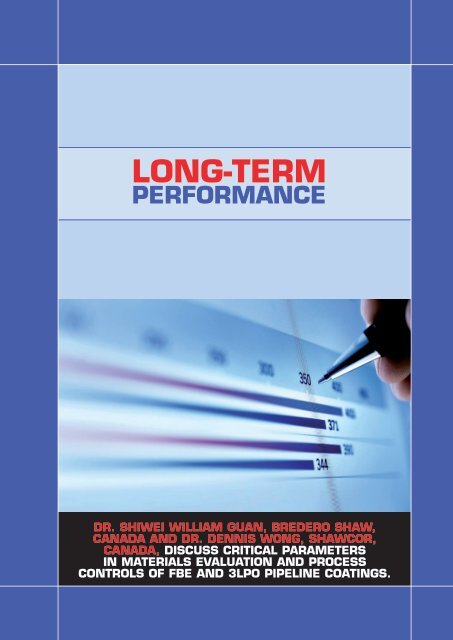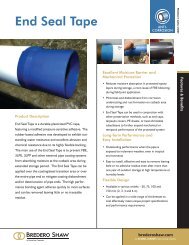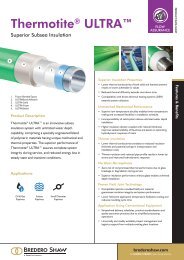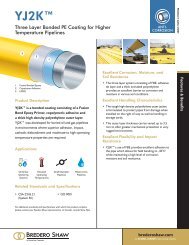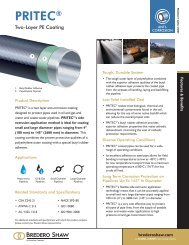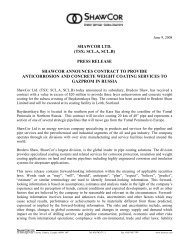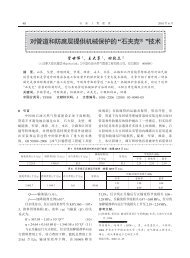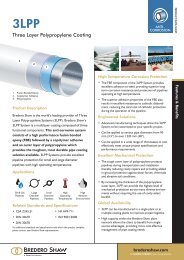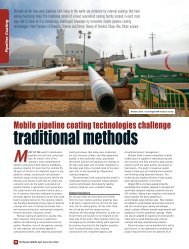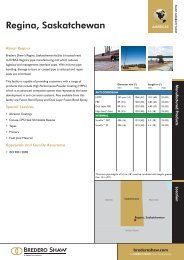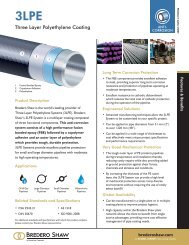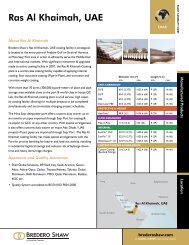Long-Term Performance - Bredero Shaw
Long-Term Performance - Bredero Shaw
Long-Term Performance - Bredero Shaw
- No tags were found...
Create successful ePaper yourself
Turn your PDF publications into a flip-book with our unique Google optimized e-Paper software.
<strong>Long</strong>-termperformanceDr. Shiwei William Guan, <strong>Bredero</strong> <strong>Shaw</strong>,Canada and Dr. Dennis Wong, <strong>Shaw</strong>Cor,Canada, discuss critical parametersin materials evaluation and processcontrols of FBE and 3LPO pipeline coatings.
( protecting against corrosion )Corrosion is the primary factor affecting thelongevity and reliability of buried oil andgas pipelines. Fusion Bonded Epoxy (FBE)and 3-layer polyolefin (3LPO) (polyethylene PE orpolypropylene PP) are the most widely used externalcoating systems for corrosion protection of newlyconstructed pipelines. Over the past decade, severalincidents of coating failures have been reported withmassive disbondment of 3-layer polyolefin coatings1-5(both 3LPE and 3LPP). These coating failures haveraised concerns in the industry worldwide about thelong-term performance of 3LPO coatings, resulting inseveral initiatives to determine the failure mechanisms6and corrective measures.Current national, international and companystandards and specifications often have a specificvalue of tested properties as an acceptance criterionDisbonded Radius (mm)403530252015105Disbondment Vs Time00 20 40 60 80 100DaysSeries1Series2Figure 1. Cathodic disbondment - time behaviour of twodifferent coatings.Tg in °C120110100908070Glass Transition Temperatures for Coatings at 65°Cfor material qualification. However, tests identifiedin these documents are relatively short-term andpredictive models for long-term performance are notavailable. Adding to the problem is that the data onlong-term behaviour of pipe coating materials, even ifavailable, are often scarce.As with any other pipeline coating systems,materials evaluation and process controls can makea significant impact on the long-term performanceof FBE and 3LPO pipeline coatings. This paperdiscusses the results of our study on some relatedcritical parameters, which include the qualification andapplied thicknesses of FBE, surface cleanliness andblasting profile, surface treatment, pipe temperatureduring coating application, weld-seam coverage andfinished coating inspection.Two examples reveal the need forlong-term evaluationsThe draft ISO 21809-1 for 3LPO pipe coatings willprobably contain a short-term (24 hours at 65 ˚C)cathodic disbondment (CD) test. China’s SY/T 0413-2002 standard also calls for a 48 hour CD test at65 ˚C. These short-term tests are intended for in-plantCathodic disbondment (mm)2520151050Cathodic disbondment test at 6550 100 150 200 250 3002 4 6 8 10 12FBE Primer Thickness (microns/mils)o C14 days28 daysFigure 3. Cathodic disbondment of a multi-layer PE coatingat various FBE primer thicknesses.600 7 14 28 60 90 120Duration of DaysFigure 2. T gof two FBE materials after exposure to wetservice environment.Table 1. Correlation of hot water soak results with thickness of aFBE coating at 75˚CThickness (µmor mil)7 days 14 days 28 days 60 days100 µm (4 mil) 2 2 2 4 - 5150 µm (6 mil) 2 2 2 4200 µm (8 mil) 1 1 1 3 - 4250 µm (10 mil) 1 1 1 3300 µn (12 mil) 1 1 1 3Figure 4. Two different blasted surfaces show an identicalprofile reading by Testex measurements.REPRINTED FROM WORLD PI PELINES November2008www.worldpipelines.com
( protecting against corrosion )quality control, which should not have been reliedon for qualifying the tested coating material for itslong-term performance. The proper approach shouldbe generating the cathodic disbondment rate ratherthan a single test for a specified period of time. Figure1 shows two coatings where the 28 days result maybe better in series 2, however the coating in series 1would be a better choice.Figure 2 shows the T gof two FBE materials afterexposure to wet service environment at 65 ˚C forFigure 5. Weld ‘tenting’ of a conventional 3LPE coating.Figure 6a duration of up to 120 days. Both standard FBEmaterials show a considerable drop in T g(20 - 25 °C) after immersion in water due to FBEplasticisation caused by moisture absorption. TheseT gvalues are measured per CSA Z245.20-2006 at aheating rate of 20 °C/min. The T gat slower heatingrates close to the pipeline operating conditions(close to 0 °C) would be approximately 10 °C lower.Learning from the results given in Figure 2, oneshould be careful in using T gas a limiting factor,particularly when only dry T gvalues are considered inmany standards and specifications for pipe coatings.Different materials behave differently at temperaturesabove T g. Some have drastic increases in permeationrates while others retain their properties much better.It is of main interest for design engineers to determinethe long-term performance of the FBE material usedin wet environments, and to define the maximumoperating temperature limit of the coated pipelineproperly.Figure 6. New approach to a multi-layer PO coating for anexcellent great weld coverage. 8Critical parametersFBE primerTable 1 shows the correlation of adhesion rating withfilm thickness of an FBE coating after hot water soaktesting as per CSA Z245.20 (CSA’s criterion is a ratingTable 2. Impact of surface preparation on adhesion property of two FBE coatingsMaterial Surface preparation Adhesion rating (hot water soak, 75 ˚C)Grit type Profile, Rz (µm) Peak count/in. 2 days 7 days 14 days 28 days 60 days 120 daysFBE#1 GL25 62 74 1 1 1 1 2.3 2.3FBE#1 GL80 35 92 1 1 1 1 1.2 4FBE#1 Substrate prepared by power grinding 1 1 1 1 5 5FBE#2 GL25 60 72 1 5 5 5 5 5FBE#2 GL80 40 98 1 1 5 5 5 5FBE#2 Substrate prepared by power grinding 1 3 3 5 5 5Table 3. Impact of surface preparation on cathodic disbondment property of FBE#1 coatingMaterial Surface preparation Cathodic disbondment (-1.5 V, 65 ˚C)Grit typeProfile, Rz(µm)Peak count/in.14 days 28 daysFBE#1 GL25 62 74 5 mm 16 mmFBE#1 GL80 40 77 5 mm 23 mmFBE#1 Substrate prepared by power grinding 25 mm Total disbondmentTable 4. Impact of improved surface cleanliness by phosphoric acid treatment on properties of FBE#1 coatingSurface preparation (GL25 grit) Avg. CD Adhesion rating (hot water soak, 75 ˚C)Acid treatment Profile Rz (µm) Peak count/in. 28 days, -1.5V,65 ˚C2 days 28 days 60 days 90 days 120 days 150 daysYes 59 - 66 74 - 76 16 mm 1 1 1.2 2 2 3No 54 - 62 73 - 75 16.5 mm 1 1 2.3 3 2.3 4www.worldpipelines.com Reprinted from World Pipelines November2008
( protecting against corrosion )of 1 - 3 for 28 days). It is interesting to note that thehot water soak exposure did not reveal any differenceamong the applied coating systems until 60 days.Figure 3 shows the cathodic disbondment(65 ˚C, -1.5 V, 14 and 28 days) behaviour of a multilayerpolyethylene coating system at different FBEprimer thicknesses. It was found that the cathodicdisbondment performance of the multi-layer PEcoating system using a 200 µm (8 mil) FBE primerexhibited comparable results to a stand-alone 350 µm(14 mil) FBE coating, under the similar applicationprocess conditions. Together with the results givenin Table 1, it demonstrates that with current FBEtechnology, there is a threshold minimum thicknessof FBE primer for multi-layer polyolefin coatings toprovide a good balance of anti-corrosion properties. Aminimum of 150 µm (6 mil) is needed and 200 µm(8 mil) should be the specified value.Surface preparationMany reported pipeline coating failures have occurreddirectly as a result of poor surface preparation of thepipe substrate before coating application. Figure 4illustrates two blasted pipe surfaces, which had anidentical profile reading by Testex measurementsbut were quite different in their microstructures, witha distinct profile-peak count difference by surfaceprofilometer. Unfortunately, long-term tests will haveto be used to differentiate the performance of pipecoatings applied onto correctly or incorrectly preparedpipe substrate surfaces. Table 2 shows the adhesionproperties of two commercial FBE coatings after 75 ˚Chot water soak testing as per CSA Z245.20, appliedto three different steel substrates using two differentgrades of steel grits and power grinding. It suggeststhat short-term hot water soak testing would not beable to differentiate the adhesion performance of thetwo coatings and the impact of surface preparation.Table 3 shows the 65 ˚C cathodic disbondmentresults of FBE#1 coating samples after applied ontosteel substrates with two distinctly different profiles.Neither short-term cathodic disbondment nor watersoak testing can reveal the impact of differentsurface preparation on the performance of the samecommercially qualified coating.Phosphoric acid treatment is one of the popularmethods of preparing a blasted steel pipe surfacebefore receiving a coating. Table 4 compares theresults of hot water soak testing and cathodicdisbodment testing of the FBE#1 coating appliedonto a steel surface with and without phosphoric acidtreatment. Short-term cathodic disbondment testingdid not give out significantly different results, but longtermhot water soak testing suggested much improvedadhesion property of the coating system with the acidtreatment.Coating application temperatureMany reported failure case histories of 3LPO coatingswere related to inappropriate application temperatures7of the FBE primer. Potential solutions have beensuggested, 7 for example, correct application of theFBE primer to the full standard applied to FBE standalonecoatings and the adopting of low applicationtemperature FBE (LAT-FBE) formulations developedfor use in 3LPO systems. An international brand nameregular FBE coating was applied at 190 - 200 ˚C ontoproperly applied steel substrate surfaces. The resultsof hot water soak testing and cathodic disbondmenttesting are given in Table 5. We also investigatedtwo LAT-FBE coatings and two regular FBE coatingsapplied at different application temperature rangesbetween 160 and 240 ˚C. Results of cathodicdisbondment testing at 65 ºC for 28 days are given inTable 6. The results suggest that unless a fully testedlow application temperature FBE powder and itsTable 5. Evaluation tests for a regular FBE coating applied at 190 - 200˚CTest CSA Z245.20 - 2006 criterion Test duration and average resultsAdhesion rating (hot water soak, 75 ˚C)24 hours and 28 days adhesionrating of 1 - 324 hours 7 days 14 days 28 days1 1.2 2 2Cathodic disbondment (28 days, 65 ˚C) 28 days. CD radius < 20 mm N/A 6 mm 14 mm 24 mmTable 6. Cathodic disbondment of four FBE coatings at different application temperatures (65 ˚C, 28 days)Application temperature ˚C LAT FBE 1 LAT FBE 2 Regular FBE 1 Regular FBE 2160 19 mm 12.75 mm N/A N/A170 20 mm 12.75 mm N/A N/A180 15.5 mm 12.75 mm 17.5 mm 25.75 mm190 15.25 mm 14.25 mm N/A N/A200 16 mm 14.25 mm N/A N/A240 11 mm 5.0 mm 9.5 mm 11 mmREPRINTED FROM WORLD PI PELINES November2008www.worldpipelines.com
( protecting against corrosion )Peel Strength (lbf/in)3503002502001501005000 50 100 150Number of days testedHot Water Soak at 75°CThermal Cycling TestFigure 7. Peel strength results of a 3LPP coating.process control has been established, maintaining apipe surface temperature of 230 - 240 ˚C is necessaryto ensure long-term performance of the coatingsystem.Weld coverageWith the conventional 3LPO side-wrap extrusionapplication, protruding pipe weld seams could causethe formation of ‘tenting’ where voids, separation ofcoating layers, or discontinuities develop around theweld neck. Accompanying with the ‘tenting’ effect isa significant reduction of the coating thickness acrossthe top of the weld compared with the coating on thebody of the pipe (as illustrated in Figure 5). 8 In extremecases such a coating thickness, reduction could beas high as 100%. To ensure adequate coating filmthicknesses for pipeline protection, most of today’sinternational 3LPO coating specifications allow only0 to 10% of the coating thickness reduction overweld seams. This requirement creates a challenge toconventional 3LPO applications. A new multi-layerpolyolefin coating approach taken in both material andapplication process control can help in tackling theseproblems, 8 as illustrated in Figure 6.Finished coating inspectionQC testing on finished 3LPO coatings is relativelya weak area in pipe coatings. The testing regimescurrently advocated in industry specifications are oftendesigned to validate the application process and maynot be capable of giving a reliable indication of longtermcoating performance.Figure 7 shows the peel strength testing results ofa plant applied 3LPP coating after hot water soak at75 ˚C and thermal cycling (16 hours exposure at75 ˚C and 99% relative humidity and 8 hours at5 ˚C and 95% relative humidity) for 150 days. Thepeel strength had significantly decreased after hotwater soak but no obvious coating disbondmentor delamination was observed after 150 days. After120 days of thermal cycling testing, the coatingdisbonded from the edges, but the peel strengthwas high and the failure was found to be cohesivefailure at the polypropylene/adhesive interface. Thegood adhesion of the plant applied 3LPP system wasa result of good surface preparation and the leastresidual stress retained from the coating applicationprocess achieved at the coating plant. <strong>Bredero</strong><strong>Shaw</strong> is currently implementing a “best practicecoating process” system in all <strong>Bredero</strong> <strong>Shaw</strong> plantsworldwide to optimise and standardise the applicationparameters in coating processes to ensure the longtermperformance of pipe coatings.ConclusionsSimply designing and qualifying a pipeline coating tojust meet the short-term and minimum requirementsof current national, international and companystandards and specifications may not be sufficientto assure that the pipeline protected by the coatingsystem has the ability to survive the operatingconditions and that acceptable performance canbe consistently achieved throughout the coatingapplication process.An approach which relies more on generatingdata to provide trends in long-term behaviour of thepipe coating system should be taken during coatingselection and PQT testing. <strong>Long</strong>-term evaluationas well as better surface preparation and coatingprocess control to optimise and standardise theapplication parameters should be implemented, inorder to ensure the long-term performance of 3LPOcoating systems.References1.2.3.4.5.6.7.8.TANDON, K. K., SWAMY, G. V., and SAHA, G., <strong>Performance</strong> of threelayer polyethylene coating on a cross country pipeline – a casestudy, 14 th International Conference on Pipeline Protection, BHRGroup, Barcelona, Spain, 29 - 31 October, 2001.PORTESAN, G., TAVES, J., and GUIDETTI, G., Cases of massive disbondmentwith three layer PE pipeline coatings, Cathodic Protectionand Associated Coatings, CEFRACOR, EFC Event nr254, Aixd-en-Provence, France, 6 - 7 June, 2002.ARGENT, C., and NORMAN, D., Fitness for purpose issues relating toFBE and three-layer PE coatings, Paper #05034, Corrosion NACExpo2005, Houston, Texas, USA, 3 - 7 April, 2005.ROCHE, Marcel, MELOT, Denis, and PAUGAM, G., Recent experiencewith pipeline coating failures, 16 th International Conference onPipeline Protection, BHR Group, Paphos, Cyprus, 2 - 4 November,2005.MOOSAVI, A. N., AL-MUTAWA, S., BALBOUL, S., and SAADY, M.,Hidden problems with three layer polypropylene pipe coatings,Paper #06057, Corrosion NACExpo 2006, San Diego, USA, 12 - 17March, 2006.CHANG, B., JIANG, H., SUE, H., GUO, S., STJEAN, G., PHAM, H.,WONG, D., KEHR, A., MALLOZZI, M., and LO, K., Disbondmentmechanism of 3LPE pipeline coatings, 17 th International Conferenceon Pipeline Protection, BHR Group, Edinburgh, UK, 17 - 19 October,2007.ARGENT, C., NORMAN, D., Three layer polyolefin coatings: fulfillingtheir potential?, Paper #06056, Corrosion NACExpo 2006, SanDiego, USA, 12 - 17 March, 2006.LAM, C., WONG, D., STEELE, R., and Edmondson, S., A newapproach to high performance polyolefin coatings, Paper #07023,Corrosion NACExpo 2007, Nashville, TN, USA, 11 - 15 March,2007.www.worldpipelines.com Reprinted from World Pipelines November2008


